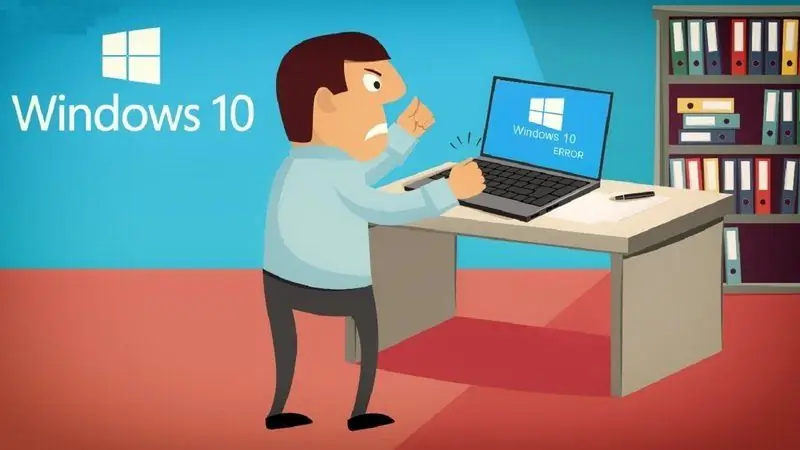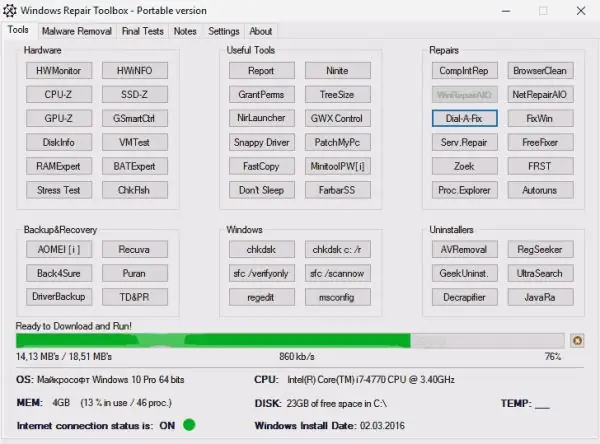
Table of contents:
- Author Bailey Albertson [email protected].
- Public 2023-12-17 12:53.
- Last modified 2025-01-23 12:41.
Fixing bugs in Windows 10: overview and comparison of methods

Windows 10 is not a reliable operating system. The developers themselves admit this - otherwise the OS would not have so many tools for diagnosing problems and fixing them. In addition, software is created only for Windows to check the integrity of files of different categories.
Content
- 1 Recovering a backup store via DISM
-
2 Identify and fix errors using the built-in SFC utility
2.1 Video: how to start the storage recovery processes and check the integrity of system files
- 3 Troubleshooting tools within the Control Panel environment
-
4 Third party software to fix system errors
- 4.1 Windows Repair Toolbox Overview
-
4.2 Microsoft FixWin 10 Overview
4.2.1 Video: How to Fix Windows 10 Errors with FixWin 10
Recovering a Backup Store Using DISM
DISM (Deployment Image Servicing and Management) is a special utility for working with an operating system backup image. On an ongoing basis, in official assemblies, the program began to be delivered from Windows 7. The application is managed inside the "Command Line" (CW), since the tool has no interface.
The most commonly used DISM utility is to repair the Windows data store. We can say that the program is at the first and last line of protection of the operating system. With the help of the backup data storage, you can restore Windows performance even in the most deplorable situations - after a virus attack or a physical error on the hard drive. However, this is far from all of its functionality. By adding special attributes to the program at the time of a query in the CS, you can get a lot of information and correct a lot of data. Since DISM works with a WIM (Backup Store) file, all changes are made in this environment.
The program can:
- display data about images of backup data;
- delete data associated with damaged images;
- make and save changes to the.wim file;
- work with the event log;
- provide information on system drivers;
- restore storage of backup data and much more.
For the program to work, you first need to start the COP, then enter special commands for control. To restore the vault data, three attributes must be used:
- / Online - sets the program to work with the current operating system;
- / Cleanup-Image - the work will be done with the entire image;
- / RestoreHealth - restore storage.
We combine all three attributes into one line, at the beginning of which we put the abbreviation DISM, and the storage will return to its original form.
-
In the search for Windows, write "Command Prompt", then open the terminal as administrator.

How to open the "Command Line" console as administrator Through the search for the system, open the "Command Line" terminal as administrator
-
Copy or write the DISM / Online / Cleanup-Image / RestoreHealth command to the terminal and press the Enter key to launch it.

How to run a Windows storage check In the console, run the DISM / Online / Cleanup-Image / RestoreHealth command
- We are waiting for the program to finish scanning and repairing the data store.
We reboot the PC to start the system with the most successful configuration.
We identify and fix errors using the built-in SFC utility
SFC (System File Checker) is a small program code for returning system files to their original form. The utility uses the backup storage as a restore source, so you need to check the storage with the DISM utility before starting a scan and system restore.
Working with the SFC utility is simple:
- Run "Command Prompt" as administrator, as shown above.
-
In the terminal, write the command SFC / SCANNOW and run it with the Enter key.

How to properly check system files for integrity After checking the storage, we run the system file recovery
- Reboot your PC.
Video: how to start the storage recovery processes and check the integrity of system files
Troubleshooting tools within the Control Panel environment
In addition to utilities for restoring the file structure of the system, many others are embedded in Windows that can make changes to the settings of a wide variety of configurations and thereby automatically fix various problems in a particular OS segment.
The set of recovery utilities in the Control Panel environment is quite varied and can troubleshoot:
- Bluetooth service;
- Windows Media Library, as well as in the player itself;
- sound reproduction environment;
- connection to the global network;
- the work of applications from the "Store";
- printer operation;
- Windows Update and many other areas of the OS.
To open the troubleshooting environment:
-
In the address bar of "Explorer" copy "Control Panel / All elements of the control panel / Troubleshooting / All categories" and press the Enter button.

How to open the troubleshooting interface in Control Panel Using the quick command in the address bar of "Explorer" open the list of utilities for troubleshooting the system
-
Click on the category of interest and click "Next" in the opened wizard for diagnostics.

Troubleshooting wizard After clicking on the line, a system wizard for troubleshooting a specific area of Windows will open
The code can run a scan immediately, or it can ask additional and clarifying questions to narrow down the search for errors.
Third-party bug fixes
In addition to standard tools for fixing system errors, there is a whole segment of third-party diagnostic programs. Perhaps, this is the only application market in which Microsoft has succeeded more than free programmers (their shortcomings are better visible). However, among third-party utilities, you can find decent tools for analyzing Windows as a whole and its individual components.
Windows Repair Toolbox Overview
Windows Repair Toolbox is more likely not a program, but a whole platform for programs and utilities of a very different purpose. It unites their common interface and goal: to preserve the integrity of the operating system and correct possible errors. Windows Repair Toolbox allows you to download utilities for specific purposes and run them inside your shell.

Windows Repair Toolbox is a platform for keeping your system running
All instruments are divided into categories:
- Hardware - the programs of this graph mainly have a scanning orientation and provide information on different devices, for example, on a processor or hard disk;
- Backup & Recovery - utilities for creating and restoring an operating system or individual components;
- Useful Tools - a separate column for reports and working with drivers;
- Windows - call the standard system utilities: SFC, CHKDISK, "Registry Editor" and "System Configuration";
- Repairs - tools for fixing errors in different areas of the operating system;
- Uninstallers - utilities for cleaning temporary files, removing unnecessary information, defragmenting disk partitions and other tasks.
In addition, the Malware Removal tab will help you find and remove malicious codes on your PC.

Malware Removal tab contains tools to find and eliminate malware
The remaining tabs are responsible for setting up the program itself, automating processes, reports and other details.
You can download the program from the official website.
Microsoft FixWin 10 Overview
FixWin 10 is a small utility that specializes in fixing the latest Windows bugs. However, many of the utility's features will work for earlier versions as well.
FixWin 10 does not require installation, you can simply download and run it.
On the welcome screen, the utility will show the basic parameters of the computer, as well as provide commands for quickly launching frequently used codes:
- SFC utility;
- creating a restore point;
- re-registering applications from the store;
-
DISM utility.

FixWin 10 program On the welcome screen, FixWin 10 shows basic information about your computer and offers quick commands to fix popular errors
To fix major system errors, go to the Windows 10 tab. There are many useful functions for fixing important system components: OneDrive, Store, system updates, and more. If you have problems with any OS component, just click the Fix button opposite the corresponding line.

Windows 10 tab contains special program codes to fix specific tasks of the latest operating system
The rest of the program sections are also useful:
- they solve problems with the file system and basic Windows components;
- start defragmentation;
- fix the situation with the connection to the network and the Internet;
- return operability to the "Registry Editor", "Command Line", the entire structure of the "Defender", etc.
You can download the program here.
Video: How to Fix Windows 10 Errors with FixWin 10
Windows is prone to numerous bugs, but there are also many tools to fix them. The user only needs to keep the backup data storage up to date, then restoring system files and the integrity of the "dozen" will be easier than ever.
Recommended:
How To Authorize A Computer In Itunes, How To Enter Aytyuns, Possible Errors And Their Solution With Photos And Videos

How to properly authorize and de-authorize a computer in iTunes. What to do if various problems arise. Proven solutions
How To Adjust A Plastic Front Door, Plus Basic Troubleshooting Instructions

How to adjust a plastic entrance door. Tools and materials for adjustment. The order of adjustment and regulations for the seasonal correction of loops
Windows 10 Desktop - Setting Up And Troubleshooting, Step-by-step Instructions And Tips

Ways to customize the desktop in Windows 10. Problems in its work, causes and solutions. Step-by-step instructions, videos
How To Find Out And Change The Screen Resolution In Windows 10 - Trying To Adjust And Fix Errors

How to increase, decrease, set a non-standard screen resolution, change its orientation. What to do if the screen blinks, changes resolution, no settings
Roofing Device Made Of Profiled Sheet On Wooden Crate, Fixing Rules And Other Features

How to choose materials for a roofing cake. The procedure for forming a wooden lathing. Laying hydro and thermal insulation. Correct fastening of corrugated board
